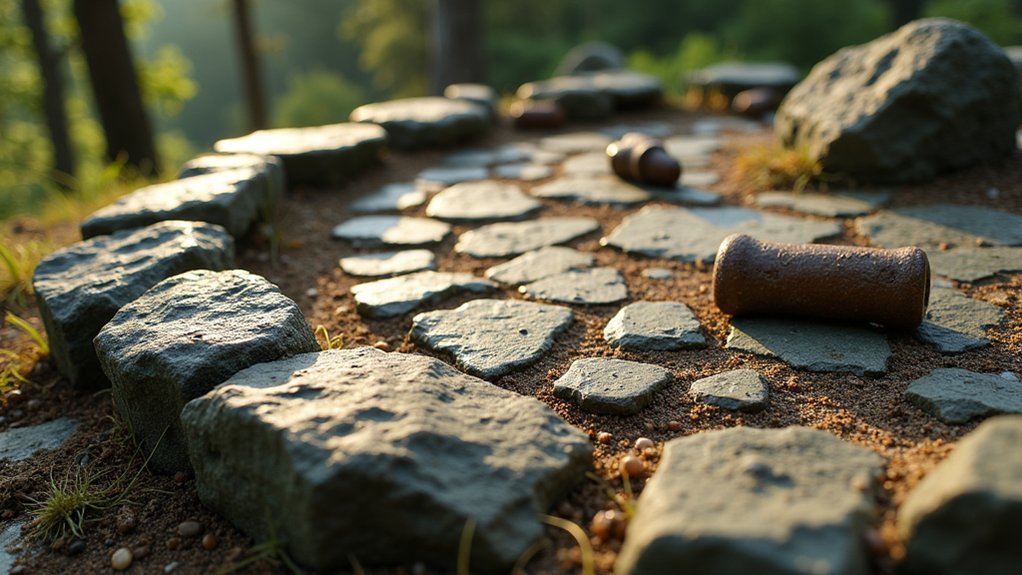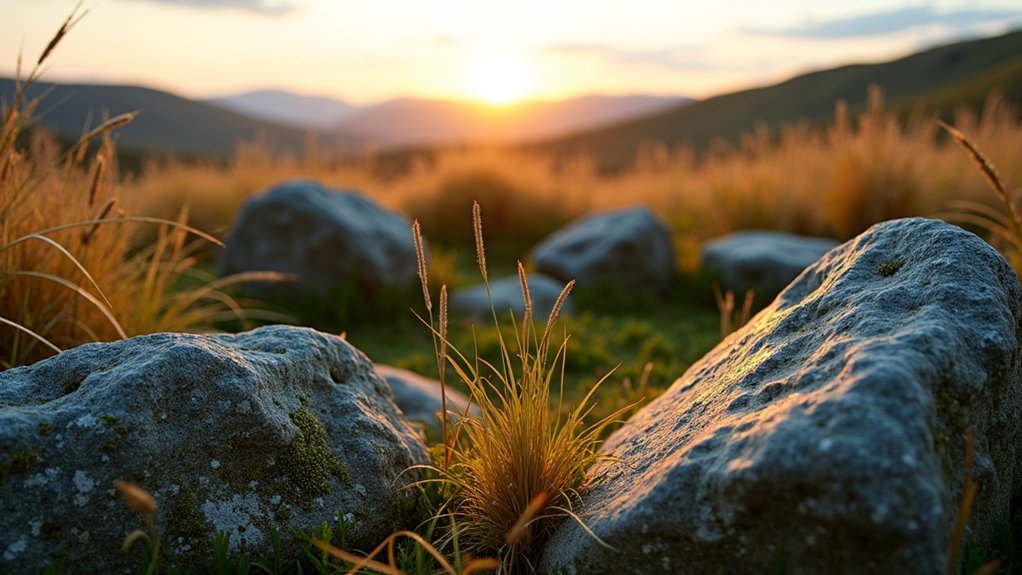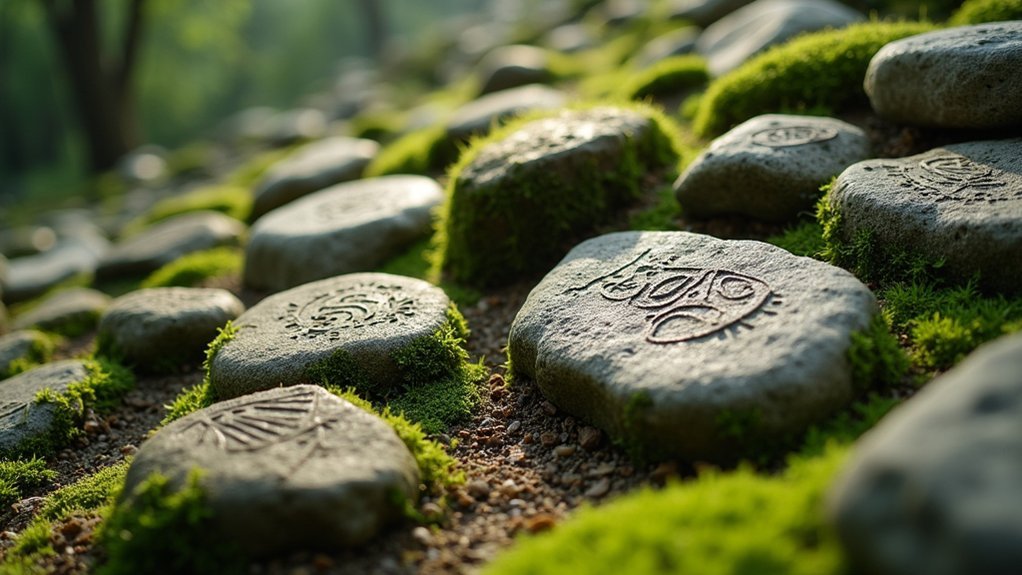You’ll discover that prehistoric builders possessed remarkably sophisticated stone-setting techniques that rival modern engineering feats, using ingenious methods to transport 30-ton sarsen blocks across vast distances and secure massive structures without any modern adhesives or machinery. They crafted specialized tools through percussion flaking, selected stones based on hardness and workability, and used natural binding materials like clay, animal sinews, and twisted tree bark to create flexible yet durable connections that’ve lasted millennia.
Materials and Tools Used in Prehistoric Stone Setting

When you examine the archaeological evidence from prehistoric stone circles, you’ll discover that ancient builders possessed sophisticated knowledge of material sourcing and tool creation.
You’ll find they carefully selected massive sarsen stones from specific locations like West Woods in Wiltshire, transporting 20- to 30-ton blocks across considerable distances using advanced techniques that scientists now study through core samples and x-ray fluorescence spectrometry.
Their stone tools included precisely crafted chisels and hammers essential for shaping and manipulating construction materials.
Archaeological sites reveal finely made implements, while submerged stone circles on the Isle of Skye show how builders adapted tools to their environment.
Ancient craftsmen demonstrated remarkable ingenuity, creating specialized tools perfectly suited to their unique coastal and underwater construction challenges.
You’ll also discover they created rope-making devices, producing string from plant fibers and animal products to lift and position stones—techniques refined over thousands of years.
Techniques for Shaping and Preparing Stones
You’ll discover that prehistoric craftspeople developed sophisticated tool-making methods using percussion flaking to create razor-sharp flint implements for stonework.
When selecting materials, you’d need to understand that ancient builders carefully chose stones based on workability, durability, and structural properties—skills evident in sites like the Ness of Brodgar.
You can also explore how controlled heat application helped soften certain stone types, making them easier to shape and refine through grinding and polishing techniques.
Ancient Tool-Making Methods
Although modern technology has revolutionized how we shape materials, the fundamental stone-working techniques developed by our ancestors over 2 million years ago remain remarkably sophisticated.
You’ll find that Stone Age communities mastered knapping, where they’d strike stones with harder materials to remove flakes and create precise shapes. Each group of people developed specialized methods using flint and chert, materials that produced exceptionally sharp edges when fractured.
You’d be amazed by their ingenuity in creating composite tools, attaching stone points to wooden shafts using sinew or resin.
The Ahrensburgian style found in northern Scotland demonstrates how ancient craftsmen could produce points, blades, and scrapers 11,000 years ago. They’d design specialized tools for hunting and food processing, showing remarkable adaptability to their environments.
Stone Selection Criteria
Creating effective tools required more than just skillful knapping techniques—prehistoric craftspeople had to master the art of selecting the right raw materials. You’d need to understand that hardness and durability determined a stone’s worth. Flint and sarsen became preferred choices because they could withstand repeated shaping and long-term use.
Archaeological discoveries shed light on sophisticated selection processes from the end of the last Ice Age. You’d have evaluated materials based on specific criteria that meant survival or failure.
| Stone Quality | Emotional Impact |
|---|---|
| Sharp edges | Life or death hunting |
| Durability | Family protection |
| Workability | Daily survival tasks |
| Availability | Community prosperity |
Sites like Ness of Brodgar reveal how stone selection connected deeply with social and ritual practices.
Shaping Through Heat
When prehistoric craftspeople discovered they could transform stubborn stones into workable materials through controlled heat application, they revolutionized their tool-making capabilities.
You’d heat stones like flint in fires until they glowed red-hot, then quickly plunge them into cold water. This thermal shock increased the stone’s brittleness, making it much easier to chip away precise flakes for sharp cutting edges.
This technique wasn’t random experimentation—it demonstrated sophisticated understanding of material properties. You could create more efficient tools with less effort, transforming previously difficult stones into manageable raw materials.
Archaeological sites across Europe reveal widespread adoption of heat treatment methods among different prehistoric cultures. By mastering temperature control and timing, these ancient craftspeople gained significant advantages in weapon and tool production, fundamentally changing their technological capabilities.
Methods of Securing Stones Without Modern Adhesives
You’ll discover that prehistoric builders mastered ingenious methods to secure stones using only what nature provided.
They’d employ natural binding materials like clay and earth to fill gaps while strategically interlocking stones based on their natural shapes.
You can apply these same techniques by leveraging gravity, friction, and the stones’ own weight to create remarkably stable structures without any modern adhesives.
Natural Binding Materials Used
Long before modern adhesives existed, ancient builders mastered the art of securing stones using materials nature provided.
You’ll discover that prehistoric peoples developed ingenious techniques using readily available resources from their environment.
These natural binding materials proved remarkably effective:
- Tree bark twisted into string – Provided flexible yet strong connections for stone construction
- Animal sinews dried and plaited – Created durable ties that could withstand weather and time
- Rawhide string from soaked and dried animal skin – Offered resilient fastening that tightened when wet
You’d also find that processed stinging nettle strips created fine, flexible string perfect for delicate binding work.
Archaeological evidence confirms these techniques were essential for constructing prehistoric monuments like stone circles and shelters, proving nature’s materials could achieve lasting results.
Stone Interlocking Techniques Applied
Three fundamental principles governed how prehistoric builders created lasting stone structures without any binding agents whatsoever.
You’ll find these ancient craftsmen relied on precision-cut interlocking joints, where stones were meticulously shaped to fit together like puzzle pieces. They’d carve specific angles and notches that allowed each stone to lock securely into its neighbor, preventing movement even during harsh weather.
You’d observe how they harnessed gravity’s power, positioning heavier stones to anchor lighter ones through sheer weight. They’d also drive wedge-shaped stones into gaps between larger blocks, creating an interconnected network that distributed stress throughout the entire structure.
These sophisticated techniques, evident at sites like Stonehenge and the Ness of Brodgar, demonstrate prehistoric builders’ remarkable understanding of structural engineering principles.
Earth and Clay Stabilization
Beyond mechanical interlocking, prehistoric builders developed sophisticated earth and clay stabilization methods that anchored monuments for millennia.
You’ll find these techniques remarkably effective at creating permanent foundations without modern adhesives.
Ancient builders employed three key stabilization strategies:
- Clay packing – Dense clay mixtures were packed around stone bases, preventing shifting and creating solid foundations.
- Strategic drainage – Sloped earth formations diverted water away from stone placements, protecting against erosion damage.
- Local material optimization – Builders combined available clay, gravel, and earth to create custom stabilization solutions.
Archaeological evidence from Stonehenge reveals stones set in carefully prepared pits filled with clay-gravel mixtures.
You can see how these prehistoric engineers understood soil mechanics, using natural materials to create structures that’ve withstood thousands of years.
Evidence From Archaeological Discoveries
While ancient stone circles have long captivated archaeologists and historians, recent discoveries across Britain’s remote landscapes are revolutionizing our understanding of these enigmatic monuments. You’re witnessing groundbreaking revelations that challenge everything we thought we knew about prehistoric settlements.
| Discovery Site | Key Finding | Time Period |
|---|---|---|
| Outer Hebrides Site XI | Massive lightning strike evidence | Ancient |
| Isle of Skye | Human occupation traces | 11,000 years ago |
| Ness of Brodgar, Orkney | Advanced Neolithic architecture | 5,000+ years ago |
| Stonehenge, Wiltshire | Sarsen stones from West Woods | 4,500 years ago |
You’ll find that virtual reconstruction technology now tracks solar and lunar movements around Na Dromannan circle for the first time in millennia. These archaeological breakthroughs reveal sophisticated Stone Age cultures that understood celestial patterns and responded to natural phenomena in ways we’re only beginning to comprehend.
Regional Variations in Stone Setting Practices

Across Britain’s diverse landscapes, you’ll discover that ancient communities developed remarkably distinct approaches to stone setting that reflected their local environments and cultural traditions.
You’ll find fascinating regional differences when examining these prehistoric practices:
- Material selection varied dramatically – Stonehenge builders combined massive sarsen stones with bluestones transported from western Wales, demonstrating sophisticated long-distance resource management.
- Geographical features shaped construction methods – Northern Scotland’s communities created submerged stone circles visible only during extreme spring tides, while settlements positioned strategically near lochs influenced their organizational approaches.
- Coastal adaptations produced unique designs – The Isle of Skye’s 11,000-year-old stone circles show distinct coastal environmental adaptations, while Orkney’s Ness of Brodgar showcases advanced Neolithic architecture reflecting specialized social and ritual practices.
Symbolic and Ritualistic Aspects of Stone Jewelry
When you examine prehistoric stone jewelry, you’ll uncover a complex world where personal adornment transcended mere aesthetics to become powerful expressions of identity, spirituality, and social standing.
You’ll discover that ancient peoples carefully selected locally sourced stones, connecting wearers to their natural landscape while establishing clan affiliations and status markers within their communities.
You’ll find that certain stones like amber and jet weren’t chosen randomly—they carried protective properties against evil spirits, making them essential spiritual tools.
Archaeological evidence reveals you’re looking at items that participated in sacred rituals, from ceremonial offerings to burial practices.
The sophisticated craftsmanship you observe reflects prehistoric artisans’ advanced skills, demonstrating that these weren’t simple decorations but complex cultural artifacts carrying deep meaning.
Evolution From Prehistoric to Early Civilization Techniques

As prehistoric peoples shifted from nomadic hunter-gatherers to settled communities, you’ll notice their stone-working techniques evolved dramatically to meet increasingly complex social and technological demands.
Archaeological evidence shows this transformation wasn’t just about survival anymore—it reflected sophisticated planning and communal cooperation.
You can observe three key technological advances that mark this evolution:
- Material Innovation: Early humans mastered string-making from tree bark and animal sinew 41,000-52,000 years ago, enabling complex tool creation.
- Construction Mastery: Monumental sites like Stonehenge demonstrate advanced engineering and coordinated community effort.
- Tool Sophistication: Fishing lines, nets, and clothing production required precise craftsmanship beyond basic survival needs.
These developments laid essential groundwork for future civilizations, showing how resourcefulness and adaptability drove human technological progress forward.
Frequently Asked Questions
What Are the Secrets of Stonehenge?
You’ll find Stonehenge’s secrets involve massive sarsen stones from West Woods, bluestones from Wales, and mysterious construction methods. You’re still puzzled by two unidentified stones and the monument’s true purpose.
Is There Any Evidence of the Stone Age?
You’ll find abundant Stone Age evidence across Britain, including 11,000-year-old tools on Skye, sophisticated string-making techniques from 52,000 years ago, and advanced Neolithic architecture at Orkney’s Ness of Brodgar spanning decades.
What Are the Three Stone Ages During Prehistoric Architecture?
You’ll find three distinct Stone Ages: the Paleolithic with simple tools and nomadic hunting, the Mesolithic featuring advanced microliths and semi-permanent settlements, and the Neolithic showcasing agriculture and monumental stone architecture.
What Is a Prehistoric Stone Circle Called?
You’d call a prehistoric stone circle a “henge” – a circular ceremonial site with standing stones, banks, and ditches. You’ll find famous examples like Stonehenge in England and Brodgar in Scotland.
In Summary
You’ve discovered that prehistoric artisans weren’t primitive at all—they’d mastered sophisticated techniques using natural abrasives, organic bindings, and precise pressure flaking. You can see their ingenuity in archaeological evidence spanning continents, where they’d adapted methods to local materials while maintaining symbolic traditions. You’ll notice how their innovations laid groundwork for civilization’s jewelry arts. These ancient stone setters prove that human creativity and technical skill haven’t changed—only our tools have evolved.





Leave a Reply